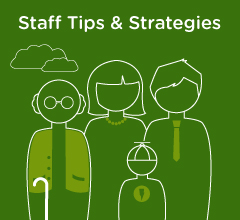Being “Heard” in the Workplace

Author:
Alison Axelrod, MSW, Employment Specialist
Diversity in the workplace benefits employees, employers and society as a whole. With today’s technological advances and better understanding of the special needs of workers with disabilities, providing accommodations for deaf or hard of hearing employees doesn’t need to be difficult. Below are some simple things to keep in mind as you start exploring your next career step.
Getting Ready for an Interview
If you are attending a job interview you may benefit from having the services of an interpreter at the interview. All private employers with over 15 employees, state and local government and federally funded private employers must provide an interpreter when it is necessary for effective communication unless it would cause an undue burden. For example, an interpreter should be provided for a deaf or hard of hearing person at a job interview or for staff training, but generally does not have to be available full time for the conduct of daily employment activities. You can provide the potential employer’s human resource department with a list of interpreting agencies to choose from and they are responsible for scheduling and paying for the service. In an interview setting, the use of an interpreter can help you express your thoughts clearly and concisely. Interpreters who are used during job interviews are not permitted to participate in the conversation and they view all information exchanged as confidential. Nothing is added or deleted from any interaction between you and the interview board that takes place. Contact the employer in advance of the interview to let him/her know the name of your interpreter and finalize all arrangements.
I Got the Job! What’s Next?
Training Challenges
Training of new employees is a challenge when the company provides speakers and classroom-style training programs. Deaf or hard of hearing employees often feel left out in meetings when they can’t fully participate. Companies can rely on computer training programs to accompany a classroom setting or provide hearing-impaired workers with translators in training sessions and meetings. Films should have captions or a written version of the script that deaf employees can follow along with. Web-based training or computer-assisted note takers can participate in group meetings to translate for hearing-impaired employees.
Making Your Work Environment Work for You
How can you make sure that your work environment is set up so it works for you? What accommodations can you ask for?
- A sign language interpreter
- A videophone
- A TTY, text telephone, voice carry-over telephone, or captioned telephone
- Appropriate emergency notification systems (e.g., strobe lighting on fire alarms or vibrating pagers)
- Written memos and notes (especially used for brief, simple, or routine communications)
- Work area adjustments (e.g., a desk away from a noisy area or near an emergency alarm with strobe lighting)
- Assistive computer software (e.g., net meetings, voice recognition software)
- Assistive listening devices (ALDs)
- Augmentative communication devices that allow users to communicate orally by typing words that are then translated to sign language or a simulated voice
- Communication access real-time translation (CART) or Speech to Text, which translates voice into text at real-time speeds
- Altering an employee’s marginal (i.e., non-essential) job functions
- Other modifications or adjustments that allow a qualified applicant or employee with a hearing loss to enjoy equal employment opportunities.
Socializing with Colleagues
Once you’re work environment is set, another challenge is developing relationships in the workplace and educating fellow employees about your disability and how to communicate appropriately. Below are some simple tips and etiquette that can be provided to your employer/HR department to help your colleagues better communicate with you. Communication builds relationships and results in a more satisfying work experience – for everyone!
- Use eye contact, a small wave, or a light touch on the shoulder to get the attention of a deaf co-worker, and the deaf co-worker will use the same techniques to get the attention of his or her hearing co-workers;
- Always maintain eye contact when speaking to a deaf co-worker, even if interpreter is present;
- Do not slow one’s speech or raise one’s volume when addressing a deaf co-worker, unless the individual is hard of hearing and requests that his or her co-workers speak a bit louder;
- Use hand gestures and point to items that one is referencing in his or her conversation, including mimicking actions such as “lunch” or “type”;
- Use visual aids, such as a PowerPoint presentation or a written agenda with notes;
- During meetings, in order to assist an interpreter to help a deaf person who may be able to lip read, enforce a rule that only one person may speak at a time (which can have other benefits aside from communicating with deaf co-workers); and,
- When a conversation between a hearing employee and deaf employee is interrupted by someone calling on the telephone or knocking at the door, the hearing employee should be sure to let the deaf employee know that he or she is stopping the communication to respond to an interruption.
Remember – to maximize your job experience you need to be “heard” and reasonable accommodations need to be in place. Your work environment needs to work for you! For more information about how JSSA’s Specialized Employment services can help prepare you for the job search and work with you after you’ve been hired, click here or send us an email: contactus@jssa.org.
Acknowledgements and Additional Resources:
- Tapping the Untapped: Including Deaf Employees in the Workforce, by Patrick Hicks and Kristina Escamilla Gilmore, Nov. 5, 2012, www.tlnt.com
- Creating Deaf Accessibility in the Workplace, by Lydia L. Callis, May 21, 2014, Huffington Post
- Workplace Accommodations, Technological Education Center for Deaf and Hard-of-Hearing Students, www.deaftec.org/workplace-accommodations
- National Association for the Deaf: http://nad.org
- Registry of interpreters for the Deaf: http://www.rid.org
- Deaf in Government: http://www.deafingov.org
